Behaviour
> Vbunce
> Teaching & Learning
> Professional Practice
A De-escalation Exercise for Upset Students. So often we find students in a stressed or anxious state of mind.

The most telltale signs are inappropriate behaviors or outbursts, negative comments, and anxiety-ridden movements such as fidgeting, leg shaking, and fist clenching.
Research evidence on bullying prevention at odds with what schools are doing. In September 2018, I wrote about the so-called “Trump effect” on bullying in schools, citing a study that found higher bullying rates in GOP districts after the 2016 presidential election.
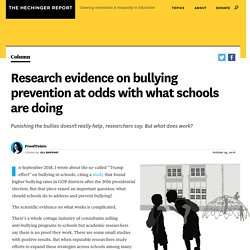
But that piece raised an important question: what should schools do to address and prevent bullying? The scientific evidence on what works is complicated.
Addressing Persistent Defiance. We all have students who test our limits.
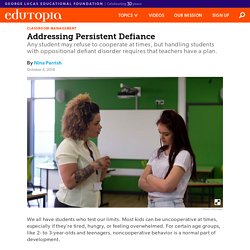
Most kids can be uncooperative at times, especially if they’re tired, hungry, or feeling overwhelmed. For certain age groups, like 2- to 3-year-olds and teenagers, noncooperative behavior is a normal part of development. In addition, up to 16 percent of all children and 40 percent of students diagnosed with attention-deficit/hyperactivity disorder have oppositional defiant disorder (ODD), which is characterized by a pattern, in multiple settings over time, of consistent negative and hostile behavior that can include deliberately annoying or upsetting others, explosions of anger and hostility, defiance or frequent arguing with adults, and then blaming others for misbehavior.
Resources - RPforSchools. Should Your First Consequence Be A Warning?
I’m frequently asked whether I recommend giving a warning as a first consequence.
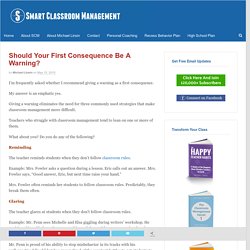
My answer is an emphatic yes.
Edutopia. “Behavior is communication. Behavior has a function.
Edutopia. A standard approach is the praise sandwich or feedback sandwich, which attempts to sidestep blame, conflict, and hurt feelings by surrounding negative feedback with positive statements. After opening with praise (“Johnny is so energetic”), the teacher brings up a specific critique (“With all that energy, he can become quite disruptive in class”), and closes on a positive note (“But he adds so much to our learning community”). While this tactic remains popular, it’s not always effective: Since people tend to remember the first and last things they hear, they focus on the praise at the ends and not the critique in the middle. The sandwich delivery softens the message and doesn’t necessarily drive it home. A Different Approach to Difficult Feedback An alternative might look more like a bundle.
Not Naughty: 10 Ways Kids Appear to Be Acting Bad But Aren't. 20 Tips to Help De-escalate Interactions With Anxious or Defiant Students.
Anxiety is a huge barrier to learning and very difficult for educators to identify.
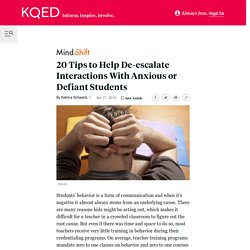
“When anxiety is fueling the behavior, it’s the most confusing and complicated to figure out,” Minahan said. That’s because a student isn’t always anxious; it tends to come and go based on events in their lives, so their difficulties aren’t consistent. When we are anxious our working memory tanks, making it very difficult to recall any salient information. Researchers surveyed a group of first graders none of whom had any reading or math disabilities.
5 Expert Strategies For Calming a Noisy Classroom. This article was written by Adam Hatch - UC Berkeley graduate, son of a teacher, brother of a teacher, and a teacher himself.

Adam started a unique English school in Taipei, Taiwan, where kids learn to research and write articles in English. The articles are published on the first ever English newspaper written by kids in Taiwan, called the Taipei Teen Tribune.
20 Tips to Help De-escalate Interactions With Anxious or Defiant Students. Strategies to Build Intrinsic Motivation. Punishment, Rewards, and Commitment The issue with classroom management policies in most institutions is that it operates on a carrot-and-stick model.
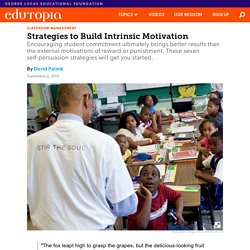
Carrots include PBIS (Positive Behavior Intervention and Supports), Classroom Economy, and other class rewards. Sticks include punishment such as detention, suspension, or withholding from other activities. Teachers and educational leaders believe that these measures will help control the students. However, self-persuasion produces more powerful and longer-lasting benefits than direct techniques of persuasion produce.
25 Chatty Class Classroom Management Strategies for Overly Talkative Students. Have a chatty class?
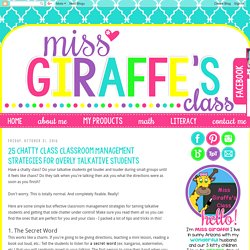
Do your talkative students get louder and louder during small groups until it feels like chaos? Do they talk when you're talking then ask you what the directions were as soon as you finish? Don't worry. This is totally normal.
StrategiesForNonMotivated. Teacher/Student Relationship+ It is extremely important to avoid negatively labeling a child.
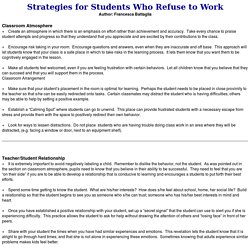
Remember to dislike the behavior, not the student. As was pointed out in the section on classroom atmosphere, pupils need to know that you believe in their ability to be successful. They need to feel that you are “on their side” if you are to be able to develop a relationship that is conducive to learning and encourages a students to put forth their best efforts. + Spend some time getting to know the student.
What to do when a student constantly refuses to work. There’s at least one in every classroom–yep, I’m talking about the kid who just sits there, and doesn’t work.
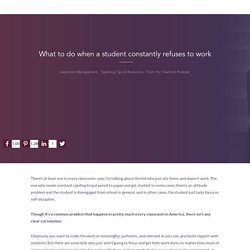
The one who needs constant cajoling to put pencil to paper and get started. In some cases, there’s an attitude problem and the student is disengaged from school in general, and in other cases, the student just lacks focus or self-discipline. Though it’s a common problem that happens in pretty much every classroom in America, there isn’t any clear cut solution. Obviously you want to make the work as meaningful, authentic, and relevant as you can, and build rapport with students.
The 5 Priorities of Classroom Management. I have discovered that there are five components of effective classroom management that establish structures strong enough to entice and motivate student learning: Developing effective working relationships with students Training students on how learning takes place in your classroom Protecting and leveraging time Anticipating student behaviors in well-written lesson plans Establishing standards of behavior that promote student learning 1.
Develop Effective Working Relationships With Your Students. Educational Leadership:Motivation Matters:Motivating Young Adolescents. A Simple Notebook System for Classroom Management. Posted 03/04/2014 3:40PM | Last Commented 08/02/2017 10:23AM Image Credit: ©Shutterstock.com/Julia Tim Hi All, When I taught middle school, I tried lots of different methods for classroom management, but I found that basic notebooks were ultimately the thing that saved me, in two ways.
I have videos on my website that explain both uses, but I'll summarize them here:
Edutopia. How to respond to rude, disrespectful student attitudes - The Cornerstone For Teachers. Au.pinterest. Edutopia. All of us have had major classroom disruptions that try our patience and push our limits. These incidents can threaten our sense of control and generate fear of looking weak to other students.
Strategies for Students With Scattered Minds. Edutopia. With so many classroom research studies published daily, you can be forgiven for missing some. The techniques below are super-tactical and, for the most part, unsung strategies that you’ll be excited to try tomorrow. Just remember two things.
Five Movement Strategies in the High School Classroom – Kenny C. McKee. Each day more research confirms the link between movement and learning.
30 Techniques to Quiet a Noisy Class.
One day, in front 36 riotous sophomores, I clutched my chest and dropped to my knees like Sergeant Elias at the end of Platoon. Instantly, dead silence and open mouths replaced classroom chaos.
17 Ideas to Help Combat Learned Helplessness. 20 Strategies for Motivating Reluctant Learners. Kathy Perez has decades of experience as a classroom educator, with training in special education and teaching English language learners. She also has a dynamic style. Sitting through her workshop presentation was like being a student in her classroom.
The 5 Priorities of Classroom Management. AnxietyBC Youth. Restorative Justice: Resources for Schools. Behavior Management Software - ClassDojo. Kids & Family. Kids & Family Kids & Family on the Blog Century-Old Museum Hosts Garden State Makers With over 40 maker exhibits, 80 galleries full of art and natural science collections, and a full day of workshops, the Greater Newark Mini Maker Faire was a hit with attendees of all ages.
Read more »
Behavioural Institute for Children & Adolescents.










